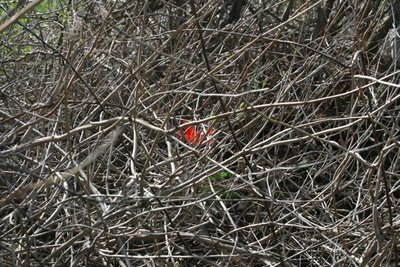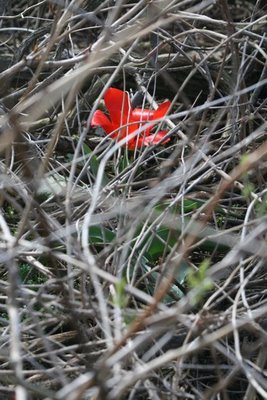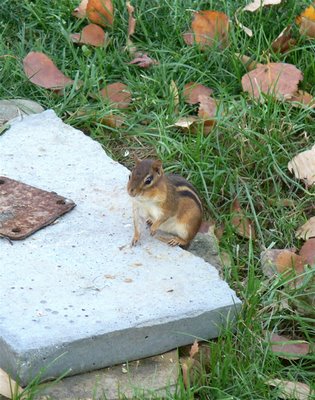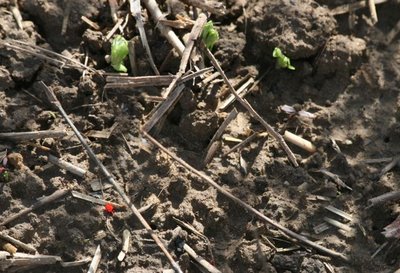LIttle Spots of Red

Fifteen years ago, when we first moved to our place, we saw a spot of brilliant red under the pussy willow on the site of the old farmhouse. The house, which sat on a rise to the east of our current home, had been burned down in the late 1970’s and replaced with the undistinguished raised ranch that, with quite a bit of modification like, say a 42 foot tall birding tower became our home in 1992. The old plantings remained, the peonies and hairy ol' Rip Van Winkle daffodils; the grape hyacinth and the pussywillow. The willow has grown into a monstrous tangle, but every spring, there’s that spot of red. It’s an old-fashioned tulip whose bulb could easily be a century old. No other tulip I’ve seen has outlasted it. Every spring it comes up in the tangle of pussy willow, protected from the deer by its branches.
 Every time I see it I think, “I should dig that tulip up and put it in the flower bed.” And I discard the thought just as quickly as it pops into my head, for I get so much more joy in the wonder of seeing that spot of red every April, shining through the intertwined branches of the sheltering willow. And as sure as I dug it up and planted it in a “proper” place, Bob the chipmunk would find it and eat it.
Every time I see it I think, “I should dig that tulip up and put it in the flower bed.” And I discard the thought just as quickly as it pops into my head, for I get so much more joy in the wonder of seeing that spot of red every April, shining through the intertwined branches of the sheltering willow. And as sure as I dug it up and planted it in a “proper” place, Bob the chipmunk would find it and eat it.  So there it stays, and there it blooms and prospers.
So there it stays, and there it blooms and prospers.I had just turned from photographing the tulip to my garden, where the snap peas were germinating. Admiring the way they pushed up through the soil, I knelt down to examine another spot of red. A red velvet mite was making its way down the pea row.
 I love these mites, and I always stop to wonder why they should be so brilliantly, extravagantly scarlet. It may be aposematic; they are said to taste very bad. Wonder who tasted one? To me, they’re the tanagers of the arachnid family. A bit of looking online revealed this at cirrusimage.com:
I love these mites, and I always stop to wonder why they should be so brilliantly, extravagantly scarlet. It may be aposematic; they are said to taste very bad. Wonder who tasted one? To me, they’re the tanagers of the arachnid family. A bit of looking online revealed this at cirrusimage.com:Red velvet mites are members of the subphyum Chelicerata, a group of critters that have tiny lobster-like claws that serve as mouthparts, a feature that relates them closely to spiders, scorpions, and harvestmen. Red velvet mites make their home in the litter layer of woodlands and forests. They live from one to several years, depending on the species. As larvae, they attach themselves to a variety of arthropods and feed parasitically. They will suck blood from a gnat or grasshopper, for instance, sometimes hitching a ride with several other mites. When red velvet mites become nymphs and then adults, they take to the soil to devour much smaller prey, including other mites and their eggs, the eggs of insects and snails, and primitive wingless insects. They do not bite humans; neither do they sting. Adult male mites release their sperm on small twigs or stalks. That ritual is followed by the male laying down an intricate silken trail to the sperm. Females spot these trails, then seek out the individual male. If he's to her liking, she sits in the sperm.* But if another male spots one of these sperm gardens, he'll promptly destroy it and replace it with his own.**
*Now, what fun is THAT?
**Now, that sounds like more fun.
I thought I could grow ANYTHING. But I'm gonna need help with a sperm garden.
Little spots of red—how they brighten my day.
Labels: heirloom tulip, red velvet mite, sperm garden






<< Home